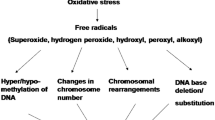Abstract
Somaclones (R3 and R4 generations) regenerated from five winter wheat (Triticum aestivum L.) genotypes were evaluated for variation in agronomic and morphological characters. Immature embryos were used as initial explant material. Comparisons for plant height, top internode length, spike length, number of seeds per spike and 100 seed weight were made between the somaclones and their parents. Some morphological variations of stem and spike characteristics were registered which demonstrate that plant height and spike length can be changed by using immature embryo culture. The results obtained may be considered a biotechnological contribution to wheat plant improvement.
Similar content being viewed by others
References
Ahlowalia, B.S. & Y. Sherington, 1985. Transmission of Somaclonal Variation in Wheat. Euphytica, 34: 525-537.
Atanassov, Z., P. Ivanov & M. Karadimova, 1990. Induction of Embryogenic Triticum aestivum L. Calli and Plant Regeneration on Different Culture Media. ‘Proceedings of International Simposium Wheat Breeding-Prospects and Future Aproaches, June 4th-8th, Albena, Bulgaria’: 398-400.
Barakat, M.H., 1994. Combining Abilityes of in vitro traits in wheat (Triticum aestivum L.) immature embryo cultures. Euphytica, 76: 169-175.
Baracat, M.H., 1996. Estimation of genetic parameters for in vitro traits in wheat immature embryo cultures involving high x low regeneration capacity genotypes. Euphytica, 87: 119-125.
Bohorova, N.E., M. van Ginkel, S. Rajaram & D.A. Hoisington, 1995. Tissue culture response of CIMMYT elite bread wheat cultivars and evaluation of regenerated plants. Cereal research communications, 23: 243-251.
Chen, T.H.H., M.D. Lazar, G.Y. Seoles, L.V. Gusta & K.K. Kartha, 1987. Somaclonal variation in a population of winter wheat. J. Plant Physiol., 130: 27-36.
Cheng, X.Y., M.W. Gao, Z.Q. Liang, G.Z. Liu & T.C. Hu, 1992. Somaclonal variation in winter wheat: frequency, occurence and inheritance. Euphytica, 64: 1-10.
Evans, D.A. & W.R. Sharp, 1983. Single gene mutations in tomato plants regenerated from tissue culture. Science, 221: 949-951.
Fennell, S., N. Bohorova, M. van Ginkel, J. Crossa & D. Hoisington, 1996. Plant regeneration from immature embryos of 48 elite CIMMYT bread wheats. TAG, 92: 163-170.
Fischer, S. & C.G. Neuhaus, 1995. In vitro development of globular zygotic wheat embryos. Plant Cell Reports, 15: 186-192.
Guenzi, A.C., D.W. Mornhinweg & B.B. Yohuson, 1992. Genetic analyses of a grass dwarf mutation induced by wheat callus culture. Theor. Appl. Genet., 84: 952-957.
Hashim, L.N.,W.F. Campbell & Y.G. Carman, 1990. Morphological analyses of spring wheat (CIMMYT cv. PCYT-10 ) somaclones. Plant Cell, Tissue and Organ Culture, 20: 95-99.
Karp, A. & S.E. Maddock, 1984. Chromosome variation in wheat plant regenerated from cultured immature embryos. Theor. Appl. Genet.,67: 249-255.
Larkin, P.Y.& W.R. Scowcroft, 1981. Somaclonal variation-a novel source of variability from cell culture for plant improvement. Theor. Appl. Genet., 60: 197-214.
Larkin, P.Y., S.A. Ryan, R.I.S. BreHell & W.R. Scowcroft, 1984. Heritable somaclonal variation in wheat. Theor. Appl. Genet., 67: 443-455.
MacKinnon, C., G. Gunderson, & M. Nabors, 1987. High Efficiency Plant Regeneration by Somatic Embryogenesis from Callus of Mature Embryo Explants of Bread Wheat (Triticum aestivum L.) and Grain Sorghum. In vitro Cellular and Developmental Biology, 23: 443-448.
Mohmand, A.S.& M.W. Nabors, 1990. Somaclonal variant plants of wheat derived from mature embryo explants of three genotypes. Plant Cell Reports, 8: 558-560.
Murashige, I. & F. Skoog, 1962. A revised medium for rapid growth and bioassays with tobacco tissue cultures. Physiol. Plant, 15, 473-497.
Qureshi, Y.A., P. Hucl & K.K. Kartha, 1992. Is somaclonal variation a reliable tool for spring wheat improvement. Euphytica, 60: 221-228.
Ryan, S.A., P.Y. Larkin & F.W. Ellison, 1987. Somaclonal variation in some agronomic and quality characters in wheat. Theor. Appl. Genet., 74: 77-82.
Sagi, H., A. Berner, E. Ace, T. Bartok & F. Sagi, 1993. Genetic Identification Agronomic Performance and Technological Quality of Tissue Culture-Induced Dwarfs of the Mv 4 winter wheat. Cereal Research Communications, 21, no.4: 309-315.
Schaeffer, G.W., P.S. Baenziger & Y. Worley, 1979. Crop Science, 19: 697-702.
Sharma, H., Y. Varnum, S. Sato, S. Baenziger & S. Metz, 1992. Analyses of Plants Derived from Wheat Tissue Culture. Cereal Research Communications, 20, no.1-2: 75-79.
Snedecor, G.W. & W.G. Cockran, 1957. Statistical Methods. The Iowa State College Press, IOWA.
Author information
Authors and Affiliations
Rights and permissions
About this article
Cite this article
Ivanov, P., Atanassov, Z., Milkova, V. et al. Culture selected somaclonal variation in five Triticum aestivum L. genotypes. Euphytica 104, 167–172 (1998). https://doi.org/10.1023/A:1018656903559
Issue Date:
DOI: https://doi.org/10.1023/A:1018656903559




